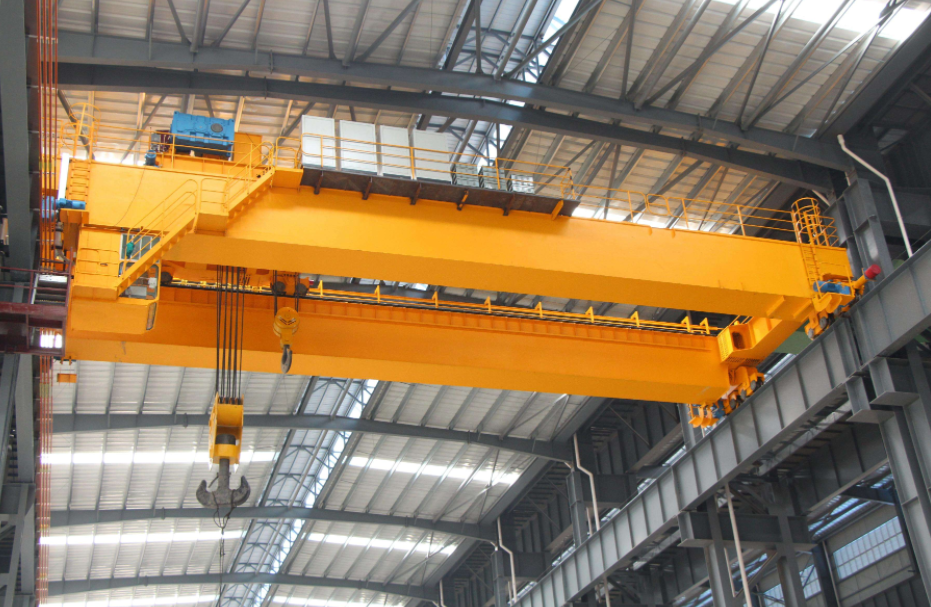Understanding Crane Span, Lifting Height, and Duty Class for Double Girder Overhead Cranes
- blog@ellsenbridgecrane.com
- Nov 19, 2024
- 4 min read
Double girder overhead cranes are powerful and versatile lifting systems designed for various industrial applications. When selecting or designing a crane, several key parameters must be understood and defined: crane span, lifting height, and duty class. These factors determine the crane's suitability for specific applications and its overall efficiency and safety in operation. This article will explore these crucial aspects in detail, offering insights into how they impact double girder overhead crane performance and selection.

1. What is Crane Span?
The crane span refers to the horizontal distance between the centers of the crane's two runway rails. Essentially, it is the width of the crane structure that spans across the working area.
Importance of Crane Span
The span directly affects the crane's ability to cover the workspace. For example, in wide workshops or warehouses, a larger span ensures that the crane can access materials across the full width of the facility. Conversely, a smaller span may suffice for narrower spaces.
Factors Influencing Span Selection
Facility Dimensions: The span must align with the width of the building or the distance between runway beams.
Load Distribution: Longer spans require robust structures to prevent sagging and ensure stability when handling heavy loads.
Crane Type: Double girder cranes can accommodate longer spans compared to single girder designs, making them ideal for large-scale operations.
Common Crane Span Ranges
Crane spans typically range from 10 to 40 meters for most industrial applications, but custom designs can extend this range to meet unique operational needs.
2. Understanding Lifting Height
The lifting height is the vertical distance that a crane can raise its load, measured from the lowest point of the hoist to the highest position it can reach.
Importance of Lifting Height
The lifting height determines the crane's ability to lift materials to a required elevation. For example:
High lifting height: Essential in industries like shipbuilding or power plants where equipment or components need to be lifted to significant heights.
Low lifting height: Sufficient for general material handling tasks in warehouses or assembly lines.
Factors Influencing Lifting Height Selection
Building Height: The available headroom in the facility sets a limit on the maximum lifting height.
Load Requirements: Taller lifting heights are necessary for stacking materials or working in multi-level spaces.
Type of Hoist: The choice of hoist (electric or manual) and its design can also impact the lifting height.
Customization for Unique Applications
Many double girder cranes are customized to achieve specific lifting heights. For instance, in heavy engineering facilities, lifting heights of over 20 meters may be required to accommodate massive equipment.

3. Understanding Duty Class
The duty class (or crane service classification) defines the crane's operating frequency and capacity. It indicates how intensively a crane is designed to be used and is essential for determining the crane's durability and lifecycle.
Duty Class Standards
Organizations like the FEM (Federation Europeenne de la Manutention) and the CMAA (Crane Manufacturers Association of America) have standardized duty classes:
CMAA Classes: Ranges from A (standby or infrequent service) to F (continuous severe service).
FEM Classes: Similar classifications, with categories such as 1Am, 2m, etc.
How Duty Class Affects Crane Selection
Light-Duty Applications (CMAA Class A/B or FEM 1Am):
Low-frequency operations.
Ideal for infrequent maintenance tasks or occasional lifting in workshops.
Moderate-Duty Applications (CMAA Class C or FEM 2m):
Medium-frequency operations.
Suitable for general manufacturing, assembly lines, or warehouses.
Heavy-Duty Applications (CMAA Class D or FEM 3m):
High-frequency operations with significant load weights.
Common in steel mills, shipyards, and construction sites.
Severe-Duty Applications (CMAA Class E/F or FEM 4m):
Continuous or near-continuous use in harsh environments.
Required for power plants, ports, and foundries.
Matching Duty Class to Application
Selecting the appropriate duty class is crucial for safety and cost efficiency. Overestimating the duty class leads to unnecessary expenses, while underestimating it results in frequent breakdowns and shorter crane lifespan.
4. Interrelation of Span, Lifting Height, and Duty Class
These three parameters are interconnected and must be balanced for optimal crane performance:
Crane Span and Lifting Height:A larger span often necessitates a higher lifting height to maintain efficient operations. For example, in wide workshops with tall ceilings, the crane needs to be engineered for both a large span and significant lifting height.
Duty Class and Span:Heavy-duty cranes with large spans require reinforced girders and advanced hoisting mechanisms to handle the increased stress.
Lifting Height and Duty Class:Cranes with higher lifting heights and frequent use demand robust motors and reliable braking systems, characteristic of higher duty class cranes.
5. How to Specify Crane Requirements
When planning for a double girder overhead crane, it’s essential to consult with a reliable supplier or manufacturer. The specification process typically involves:
Surveying the Facility: Understanding the dimensions, layout, and operational requirements.
Defining Operational Needs: Including maximum load weight, lifting frequency, and the type of materials being handled.
Customizing the Design: Based on span, lifting height, and duty class requirements.
6. Real-World Example
Consider a steel mill requiring a crane to handle molten metal ladles. The facility has a span of 25 meters, requires a lifting height of 12 meters, and operates 24/7. In this case:
The span must accommodate the workshop's width.
The lifting height ensures safe transport of the ladles over obstructions.
The duty class must be severe-duty (CMAA Class F or FEM 4m) to handle continuous use and extreme conditions.
7. Conclusion
Understanding the crane span, lifting height, and duty class is critical for the efficient and safe operation of double girder overhead cranes. These parameters not only influence the crane's performance but also its durability, cost-effectiveness, and adaptability to specific industrial applications.
By carefully assessing your operational needs and consulting with experienced professionals, you can select a crane that perfectly meets your requirements, ensuring optimal productivity and a long service life.








Comments